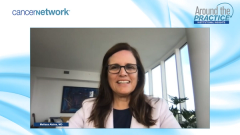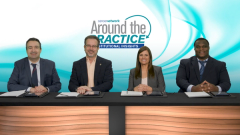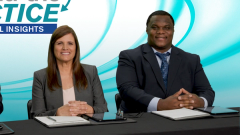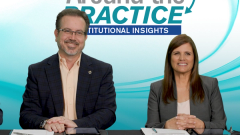
Transplant-Ineligible NDMM: Optimizing Therapy for Frailer Patients
Experts from the Moffit Cancer Center work to identify frail patients with transplant-ineligible NDMM and consider how best to select first-line therapy for this population.
Episodes in this series

Transcript:
Melissa Alsina, MD: I want to add that they did a superb analysis in the MAIA study, looking at frail patients, or looking at patients who were older than 75 or had high-risk myeloma or renal insufficiency. In all those subgroups a VRd [bortezomib, lenalidomide, and dexamethasone] was better than Rd [lenalidomide and dexamethasone]. Now, you can argue with me, but I think that for any patient with transplant-ineligible myeloma, the standard of care should be DRd [daratumumab, lenalidomide, dexamethasone]. It should not be Revlimid [lenalidomide] and dexamethasone. It should be DRd, or in selected patients, you might choose to do RVd [lenalidomide, bortezomib, and dexamethasone] because they have high-risk myeloma, or even RVd-lite, daratumumab.
Ken Shain, MD: Yes, I think that’s a great point. We talk about transplant-ineligible as this bucket, but there’s a whole heterogeneous group of individuals. There are transplant-ineligible patients who can even be on a quadruplet [drug regimen]. We have those who are ineligible who should be on a triplet. I think you said it very well; there are subgroups that all benefit from having a monoclonal antibody added to the [lenalidomide, dexamethasone] arm. But there are in fact a smaller group of patients where, maybe to Brandon’s point, it may be that 2 drugs are the right drugs. There are those small groups where you walk in and think, how am I going to take care of these individuals? But I think we know, if you’re over 75, if you’re high risk, if you are ISS III [International Staging System, stage III], these are all things in which you can still benefit from having a monoclonal antibody vs [lenalidomide, dexamethasone] alone. These are things that are working. And then again, back to the frailty, as frail as you can be and be on a phase 3 study, they showed that DRd is better than Ld [lenalidomide, dexamethasone] at any point, with frailty. So again, the data are there for us, subgroup analysis, but those are things we need to think about when we’re talking about this.
Rachid Baz, MD: Yes, I think you make a good point related to frailty. I think a lot of the frailty data come from patients enrolled in a clinical trial, and in the real-world we see patients who are going to be in a fitness category called very frail. We have certainly seen it in our investigator-initiated study, where we’ve seen half the patients were frail on our study. But not only did they have 2 points on the IMWG [International Myeloma Working Group] frailty score, we had patients who had 3 or 4 points, very frail patients, wheelchair bound, incontinence, dementia, etc. So these are things that, perhaps there may be a subset of patients who could be treated less intensely. I think that’s where the field needs to look more because frailty is one of the most important determinants of outcomes for those patients. The only plug I have would be a modified geriatric assessment is not a time-consuming thing, and it gives you very helpful information that you are not going to get in any other way. The one I do is a quick…in the office, and then a quick mini-cognitive scale, so draw a clock, remember 3 words, and this gives you a very powerful insight into the patient’s frailty.
Transcript edited for clarity.
Newsletter
Stay up to date on recent advances in the multidisciplinary approach to cancer.






















































































